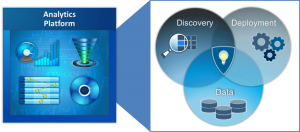 Has analytics become just a buzzword, the hype du jour? It’s great that analytics are now cool, but few people have taken then time to understand what analytics really are and how they can help solve their business problems.
Has analytics become just a buzzword, the hype du jour? It’s great that analytics are now cool, but few people have taken then time to understand what analytics really are and how they can help solve their business problems.
Last month at the the 30th Annual International Maintenance Conference, I led a discussion was how industrial organizations are turning to analytics to drive operational excellence across their enterprise by improving the overall reliability and performance of their capital assets. Following the presentation, I had enthusiastic conversations with a few of the attendees.
Coming away from those conversations, I was struck by how varied and narrowly focused some of their perceptions were regarding an analytic platform. And more importantly, what it takes to drive value from that platform back into a business team. Most organizations gravitate towards the math and the algorithms when discussing analytics, but that is such a small part of the overall system. True value only comes from knowing and embracing what lies beneath.
If we acknowledge that the “math” is only a small piece of the puzzle, what does an analytic platform actually consist of? The simplest form is to think in terms of Data, Discovery and Deployment.
 Data
Data
Data is the foundation of course, and good data is critical for good analytics. Data is often the first challenge that you need to overcome, and that challenge presents itself in many forms. It is too complex, it is in the wrong shape, it is arriving too quickly, or it’s simply too big! Those problems are very real, and often present a perceived obstacle so big that organizations struggle to get started. So as you consider an analytics strategy, make sure you think about a robust, scalable data management strategy as well. By appropriately defining a structured data model, you can ensure consistency and repeatability as you integrate, cleanse and reconcile data sources. Big data management and processing should no longer be debilitating to your analytics strategy.
Discovery
Discovery leverages the “raw material” from your data strategy, and supports the act of finding something or deriving insight that was not previously known. This is what most people think about when considering analytics, but analytics is also wide reaching. Let me pose a question --- If you were building a new house, would you only buy hammers to do it? Of course not, but that is what many organizations tend to do with analytics. They lock themselves into one tool or method for solving problems. Unfortunately, if all you have is a hammer, everything starts to look like a nail! I would argue that organizations need a wide and deep portfolio when thinking about an analytic discovery environment. Most organizations have a wide range of analytical skillsets so consider having available capabilities that align to each type of user - from executive to engineer to data scientist. Those capabilities may encompass data visualization, simple business rules, pattern matching algorithms, optimization routines, advanced machine learning, etc. It is important to consider a framework that helps bridge the gap between your subject matter experts and your data science community.
Deployment
Deployment is often overlooked and underestimated, but arguably serves the most important role. Deployment provides the foundation to operationalize the insights obtained during the discovery phase. Without deployment, the model you built is purely an academic exercise and there is no action or change - and consequently, no value! Deployment has two main areas of focus – 1) where the insight/model is run and 2) how do the results get surfaced. Where to run the model is influenced by the location of the source data, the time sensitivity of the action to be taken, etc. Consider a platform that allows you to operationalize insights throughout the enterprise without having to rebuild your base model. This could be at the edge (in or near the device), in-stream (of data movement), in-database (cloud or enterprise) or ad-hoc execution. When surfacing the results, organizations should consider systems that provide the greatest flexibility for their end users. Key factors to consider are their experience, skill set and the business process impacted. Insights (results) may need to be integrated into web/mobile reports, automated alerts, prescriptive actions tied to a case management system and/or other custom business interface. If the insight isn’t surfaced at the right time and in the right context, the business opportunities and value will be lost.
So as you consider embarking into analytics, remember that scalability and flexibility are critical to an effective strategy. Don’t be afraid of what lies beneath math! With the right platform, you can adapt to changing conditions, systems and processes. Embrace the fact that the business landscape is continuously changing. And leverage that change to seek new business opportunities or drive competitive advantage for your organization.
